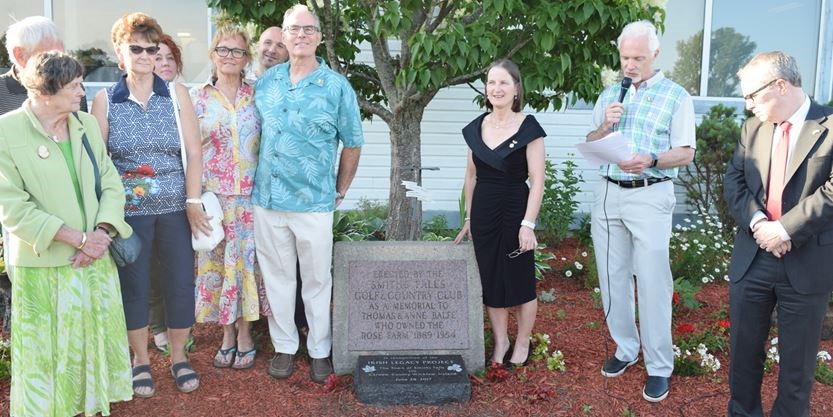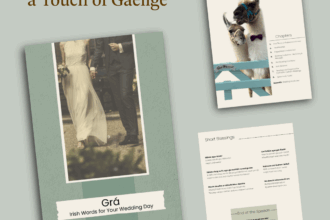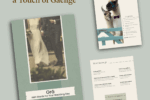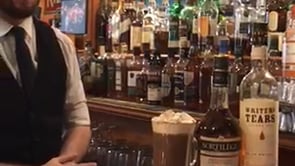It was a long way from home and yet, 19 Irish visitors had a homecoming of sorts this week.
The delegation from south County Wicklow, south of Dublin, have been visiting Smiths Falls and vicinity for the past few days, staying until Sunday, July 2, but on June 28, came to a place of familiar rolling green hills, that was once home to Irishmen and women like them.
The lands where the Smiths Falls Golf and Country Club now operates was once the home of the Rose Hill Farm, founded by Irish settlers from Wicklow. The farm was operated by Irish descendants Thomas and Anne Balfe, who ran the farm from 1889 to 1954.
The delegation, along with Smiths Falls Mayor Shawn Pankow, Ireland’s Ambassador to Canada, Jim Kelly, and others, were on hand to rededicate a monument to the Irish settlers, and to the Irish Legacy Project, linking Smiths Falls with Carnew, County Wicklow.
The Irish helped shape the community we know today. Today we celebrate that ancestral connection “Smiths Falls Mayor Shawn Pankow”The rededication was to renew a very important part of our history, said Pankow, during the outside ceremony, held as part of the Smiths Falls and District Chamber of Commerces annual golf tournament on Wednesday, June 28. The visit, he hopes, will rekindle a long lost connection.
One of the Balfe descendants, John Balfe, was on hand at the dedication ceremony, and reminded the participants that while the farm house no longer stands, the fireplace inside the golf club is made with stone from the original house.
Johns father was the great-grandson of the Wicklow settlers and he told many stories of their homestead, he said. But the Balfe story is not unique. During the Canada 150 celebrations that week, he commended the open hearts and helping hands, that welcomed new Canadians back then and now. Without the kindness of people around them, (the Irish) would not have made it.
Trish Kenny, a member of the Irish delegation, said that back in Ireland, the first stirrings of the rekindling came in 2013, during a historic re-enactment of the clearing of the Coollattin Estate, where the landlord, Lord Fitzwilliam, cleared his lands of tenants.
It was a very moving, poignant occasion, said Kenny. It reduced me to tears¦ It really affected me.
Many walked from south Wicklow to New Ross, County Wexford, a two-day walk. But even after their crossing, they left our hellish life for another, said Kenny. When they arrived in Canada, they were given a pick and a shovel, and told to go find their line, and built shelter before the snow began to fly.
Many years later, the Irish delegation went out to the Smiths Falls graveyard, where we paid our respects, said Kenny. What an amazing life and legacy they have left.
The name Balfe was, and remains, a common name in Wicklow, so much so that there is even a Balfe Meadow where she used to go draw water from as a girl, as the region did not get running water until 1969.
We are very proud to be part of your family, said Kenny.
Fellow Irish citizen Kevin Lee, a historian who visited Smiths Falls in 2014, spoke of the dark, troubled years of Ireland in the mid-1800s, during the time of the potato famine, which drove so many from Wicklow and other parts of the island of Ireland. For the thousands who filled the famine coffin ships, which crossed the Atlantic like a cork, they had to contend with very, very crowded holds filled with vomit and excrement, where every vestige of human dignity was tossed off the ship, Lee said. There was often no medical treatment on board the ships, nor were there last rites offered before death by a priest.
(On a lighter note, Lee poked fun at the complaining of some of his fellow Irish travellers for the 2017 journey, who had to travel 19 hours by plane, via St. Johns, Newfoundland.)
Lee recalled the recent visit the Irish delegation paid to Jones Falls, to visit the unmarked graves of Irish labourers who helped build the Rideau Canal.
They were buried under a cloud of anonymity, he said. We are proud and privileged to have travelled those (same) tracks.
Just before the rededication of the monument, which was topped with some soil from Wicklow, Pankow pointed out that the new stone in the ground was donated by Kincaid and Loney Monuments of Smiths Falls.
He called Smiths Falls a community (that is) Irish at its heart, not the least of which is because, according to the 1871 census, 63 per cent of Smiths Falls residents stated that they were of Irish origin.
Golf dinner
Once inside, Pankow told the crowd that the visit was a tribute to the early settlers, and that the Irish helped shape the community we know today. Today we celebrate that ancestral connection.
While the Coollattin settlers had to leave Wicklow under dire circumstances, unlike other farmers kicked off of their lands, these people were fortunate to have a landlord, Lord Fitzwilliam, who shepherded 6,000 people to this land, helping pay for their passage to Canada, and even for carts to help transport the people to Wexford.
While the Atlantic voyage was sometimes horrific, Pankow pointed out that the Irish visitors of 2017 had a much better maritime voyage of sorts, getting to paddle in a voyageur canoe.
It was the highlight of their trip, to do something so Canadian, said Pankow with a smile.
Pankow himself took a tour of south Wicklow with his family during the summer of 2016, and he commended Lee for being instrumental in renewing this connection, between the two communities.
Lee then introduced Ambassador Kelly, who, in turn, thanked Irishman Ian Ashe of Ottawa who made him aware of the Coollattin connection to Smiths Falls almost as soon as I arrived in Canada last August, he said.
Kelly, a native of Dublin, told the mostly Canadian crowd that the potato famine (An Gorta Mor in Gaelic) was the great tragedy of Irish history, with about a million people dying of starvation, and a million people emigrating. According to the Encyclopaedia Britannica, Irelands population, which stood at 8.4 million in 1844, had fallen to 6.6 million by 1851.
The Irish dispersed around the world during the famine and thereafter. One country that was open to their arrival was Canada and, in turn, the Irish were an enormous influence on Canada. Along with his wife Anne, who hails from County Limerick, Kelly has visited various memorials to Irish potato famine victims in Canada

from Grosse Ilse outside of Quebec City, to Ireland Park on Torontos Lake Ontario waterfront, opened by Irish President Mary McAleese in 2007.
But it was a Celtic Cross in Martindale, Quebec, that the couple really found moving.
It struck both of us that there was more than a passing resemblance to Annes County Limerick, he said of the rolling green hills of the Laurentians. The Irish who settled there may have found the landscape a small solace, so far from home.
The timing of the Irish visit came at an opportune time, and he hoped that the Irish visitors get something special from the Canada 150 event, he said.
While the links between Canada and the United States are well documented, he stressed that the links between Ireland and Canada are equally deserving of attention, he said, and that this visit is helping in reviving those historic links.
By: Desmond Devoy – NCR Correspondent Celtic Canada –
First appeared in Metroland SmithFalls








